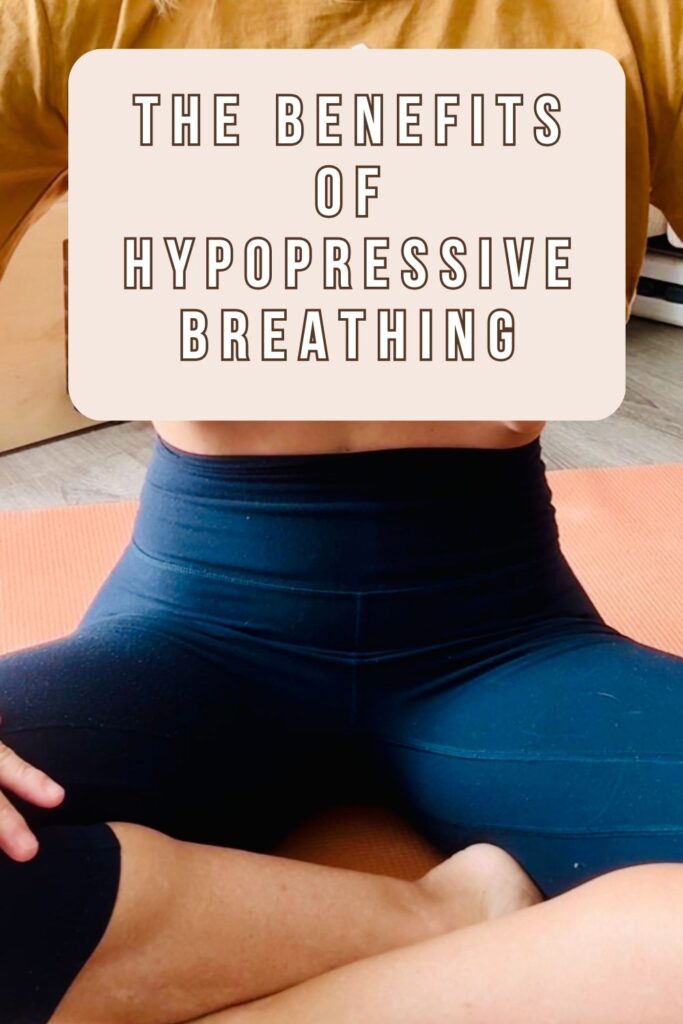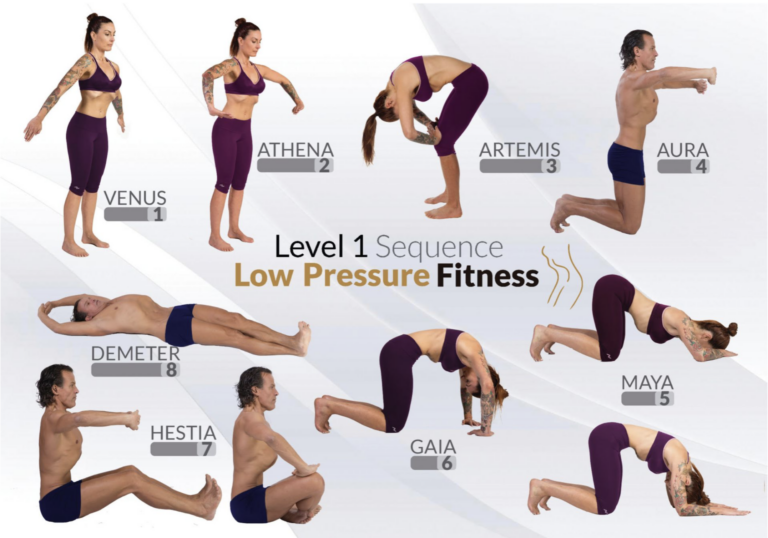Benefits of Hypopressive Breathing

Did you know that you can improve your overall health and well-being, your core strength, and your posture simply by the way you breathe? Have you ever thought about how you breathe? Or did you even know there are a few different ways you can breathe? This post is to talk about the benefits of hypopressive breathing and get exited because there are SO MANY benefits of hypopressive breathing!
What is Hypopressive Breathing
The word HYPO-PRESSIVE means: To reduce pressure. Hypopressive breathing is the type of breathing performed during a low pressure fitness flow, and really should be adopted as the main way of breathing throughout the activities of your day.
The hypopressive breathing technique is performed by inhaling with focus on expanding the rib cage (also called 360 deg breath), allowing the rib cage to expand, 3-dimensionally, in all directions. The chest can rise a bit, as the sternum lifts, but the belly should should not move during this breathing technique.
This is a deep, slow, and rhythmic breathing pattern. Ideally there should be an exhalation twice as long as inhalation. Example: inhale 4 seconds, exhale 8 seconds.
During a low pressure fitness flow, hypopressive breathing is comprised of two parts:
- Latero-costal breathing (aka rib cage breathing or 360 deg breathing)
- Abdominal vacuum technique
What Does Hypopressive Breathing Look Like?
One of the main aspects of hypopressive breathing is that it is deep, slow, and rhythmic. It should be the opposite of hyperventilation (fast, short breaths).
- Inhale through the nose
- Exhale through the mouth (focus on long and slow exhale)
- Ribs expanding in all directions during inhale
- Lengthening through the spine and growing during exhale
- Sternum lifting on inhale
- Sternum lowering on exhale
- Very little to no belly expansion
- No elevation of shoulders
- Filling the lungs from bottom to top
Rib cage breathing vs belly breathing vs chest breathing
1. Belly Breathing
This is the appropriate way of breathing when you are at rest. With belly breathing, as the diaphragm moves inferiorly to bring air in during inspiration, the pelvic floor muscles move caudally (inferiorly) as well to reduce resistance of inhalation. And on exhalation, and diaphragm moves up, the pelvic floor rises as well. This is a great type of breathing for relaxation of the pelvic floor, and is a necessary type of breathing for certain conditions, such as pelvic floor tension and also during pregnancy to prepare for delivery. This is not a bad way to breathe, however, there may be a better way of breathing, which activates the core and pelvic floor muscles more effectively.
2. Rib Cage Breathing
When you direct your inhale more into the rib cage, expanding the ribs in all 360 degrees, and filling the lungs from bottom to top and in a 3-dimensional fashion, there is a thought that the diaphragm stays a little more lifted and opens, the rib cage expands and the pelvic and abdominal organs lift (via connections of the fascia) and they lift off of the pelvic floor, decreasing pressure through the abdominal cavity. Then on exhale, you think of axial lengthening through the crown of the head, which further decreases pressure in the abdominal cavity and the pelvic floor muscles are reflexively activated, as well as the deep core stabilizing muscles.
Please note that rib cage breathing is not chest breathing. With chest breathing, breaths are shallow and often the upper chest and shoulders rise and fall with each breath cycle. This type of breathing does not fill the lower part of the lungs, and can cause shorter, quicker breaths, leading to a more hyperventilatory state.
The main benefits of hypopressive breathing
1. Reduce intra-abdominal pressure
Most of the tasks we perform in a day cause an increase in intra-abdominal pressure. This increase in pressure puts more pressure down through the pelvic floor or forward through the anterior abdominal wall. With postpartum symptoms, such as prolapse or diastasis rectus abdominus, this increase in pressure can make the recovery period more difficult and can prolong symptoms related to these conditions.
Hypopressive breathing is designed to reduce pressure in the abdominal cavity, lift the internal organ, release pressure from the pelvic floor and anterior abdominal wall, and involuntarily activate the core and pelvic floor muscles. This type of breathing has also been shown to close a diastasis and improve prolapse.
Please note: The abdominal vacuum is an added bonus to this reduction in intra-abdominal pressure, but the lateral-costal breathing is decompressive in itself.
2. Optimize Pelvic floor and core strength
The local spinal stabilizing muscles are deep and attach directly to the spine. In recent research, the core has been determined a dynamic system involving the transverse abdominis, pelvic floor, diaphragm, and multifidis muscles (1).
Since the deep core stabilizing muscles and the pelvic floor are primarily involuntary muscles, meaning that they should be active during our daily activities without us thinking about them, one of the best ways to strengthen them is with our breath.
This study, by Nicole Nelson, states: ” much of the literature suggests that diaphragmatic activity can assist with stabilization of the trunk, which suggests that breathing patterns that optimize diaphragmatic control are integral to the generation of core stability (5).
By correcting the breathing pattern into the ribcage instead of into the belly, you will decompress the pelvic floor muscles and reflexively engage them with every breath! This happens because of the movement of the diaphragm.
There is a thought that instead of only dropping inferiorly, as with belly breathing, the diaphragm moves more laterally and remains a bit more elevated, so there will be less pressure down through the abdominal cavity and onto the pelvic floor, allowing a more adequate contraction of the pelvic floor during exhale. This means that you can strengthen your pelvic floor muscles throughout the day, simply by the way you breathe!
When you allow your belly to expand on inhale, this will fully relax the pelvic floor and deep core muscles, but when you breathe into your ribcage, these muscles are reflexively engaged.
In addition, the “drawing in” of the abdominal wall during the abdominal vacuum technique has shown an increase in thickness of the transverse abdominis, internal oblique, and external oblique muscles in ultrasound studies (6).
3. Cardiovascular benefits
- Improved lung capacity
- Research has found that the more movement in the diaphragm in inspiration and expiration, the higher the amount of air that moves in and out of the lungs with each respiratory cycle (2). When we focus our breath into our rib cage, filling the lungs from bottom to top, we will improve the depth of our breath and our overall lung capacity.
- Lower blood pressure
- Studies have shown a decrease in blood pressure with slow, rhythmic breathing, as a long slow exhale activates the parasympathetic nervous system.
- Improved circulation and lymph flow
- With a slow and controlled inhalation, there is improved venous return (blood coming back to the heart), which causes an improved cardiac output (how much blood the heart pumps in one minute) (2).
4. Visceral Mobilization
As the diaphragm moves throughout each breath cycle, the abdominal organs must move as well to make room for this breath. Also, with a more managed intra-abdominal pressure, the organs will have less resistance to movement (4).
During pregnancy, hypopressive breathing can optimize the position of the uterus and also help strengthen uterine contractions for labor and delivery.
5. Diaphragmatic mobility
When we think about breathing into our rib cage, filling the lungs from the bottom up, we are training our diaphragm with each breath and also creating optimal movement from the diaphragm. Compared with shallow breathing, there will be much more inferior, lateral, and superior movement.
6. respiratory Muscle Strength
The primary respiratory muscles are trained with each deep inhalation and exhalation and each lifting and expansion of the thorax and ribcage.
7. Spinal Decompression
With hypopressive breathing, spinal elongation is emphasized on the exhale, with the goal of maintaining this length and space throughout the breath cycles. When adding in the abdominal vacuum, there is even further spinal decompression.
8. Calming of the nervous system
Deep, slow, rhythmic breathing slows the heart rate and activates the vagus nerve, which communicates with the body’s parasympathetic nervous system, which decreases respiration and heart rate and prepares the body for rest (2). This type of breathing prepares the body to remain calm under stressful situations (including labor)!
In this way, hypopressive breathing can help with anxiety!
9. Constipation
Hyporessive breathing helps with constipation and promoting regular bowel movements with the combination of slow, rhythmic breathing and visceral mobilization. Specifically slower exhalation, which activates the parasympathetic nervous system, helps to promote digestion.
Here is a great video showing this: Dr. Tamara Rial Instagram video
10. Heal a diastasis
Hypopressive breathing helps close a diastasis by:
- Reducing intra-abdominal pressure
- Strengthening and tightening the abdominal fascia
- Strengthening the core and bringing the abdominal muscles together
11. Improve pelvic organ prolapse
Specifically the abdominal vacuum has been shown to reduce or improve pelvic organ prolapse.
The abdominal vacuum
In addition to lateral-costal breathing, during hypopressive training, an abdominal vacuum is performed after the third breath cycle. After a deep exhalation, the glottis is closed, the breath is held, and inspiratory muscles open and lift the rib cage without taking in any air. This creates a negative pressure (like a suctioning effect) that draws the diaphragm up and the abdominal wall in, lifts the internal abdominal and pelvic organs, and reflexively engages the pelvic floor muscles and deep core stabilizing muscles.
The abdominal vacuum enhances the benefits from the already negative pressure produced with the lateral costal breathing and the low pressure fitness postures.
What is intra-abdominal pressure
This is the pressure inside the abdominal cavity. Certain activities will increase intra-abdominal pressure: sneezing, coughing, jumping, holding breath when having a bowel movement, heavy lifting, pregnancy, etc.
Fore more details on the basics of hypopressive breathing:
Check out this Blog post!
www.aristptandwellness.com/hypopressive-breathing
Resources
- Kolar P, Sulc J, Kyncl M, et al. Stabilizing function of the diaphragm: dynamic MRI and synchronized spirometric assessment. Journal of Applied Physiology. 2010;109(4):1064-1071. doi:https://doi.org/10.1152/japplphysiol.01216.2009
- Russo MA, Santarelli DM, O’Rourke D. The physiological effects of slow breathing in the healthy human. Breathe. 2017;13(4):298-309. doi:https://doi.org/10.1183/20734735.009817
- Gerritsen S, Guido. Breath of Life: The Respiratory Vagal Stimulation Model of Contemplative Activity. Frontiers in Human Neuroscience. 2018;12. doi:https://doi.org/10.3389/fnhum.2018.00397
- Małgorzata Wójcik, Grażyna Jarząbek-Bielecka, Piotr Merks, et al. Visceral Therapy and Physical Activity for Selected Dysfunctions, with Particular Emphasis on Locomotive Organ Pain in Pregnant Women—Importance of Reducing Oxidative Stress. Antioxidants. 2022;11(6):1118-1118. doi:https://doi.org/10.3390/antiox11061118
- Nelson, Nicole MS, LMT. Diaphragmatic Breathing: The Foundation of Core Stability. Strength and Conditioning Journal 34(5):p 34-40, October 2012. | DOI: 10.1519/SSC.0b013e31826ddc07
- Iria Da Cuña-Carrera, Alonso-Calvete A, Soto-González M, Lantarón-Caeiro EM. How Do the Abdominal Muscles Change during Hypopressive Exercise? Medicina-lithuania. 2021;57(7):702-702. doi:https://doi.org/10.3390/medicina57070702
- Armstrong A, Klaus Jungbluth Rodriguez, Sabag A, et al. Effect of aerobic exercise on waist circumference in adults with overweight or obesity: A systematic review and meta‐analysis. Obesity Reviews. 2022;23(8). doi:https://doi.org/10.1111/obr.13446
- Isabella Martins Rodrigues, Luiza A, Amanda Piaia Silvatti, Karine Jacon Sarro. Current evidence for hypopressive exercises in healthy women: A systematic review. Journal of Bodywork and Movement Therapies. Published online January 1, 2024. doi:https://doi.org/10.1016/j.jbmt.2024.01.012







